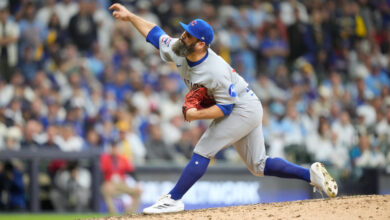
No, Cubs Could Not Have Signed Carlos Correa for $300M Last Year
Cubs fans have been doing a lot of hand-wringing and pearl-clutching over the team’s lack of impact talent this winter, but the latest source of it is a bit misplaced. Rather than focusing on what they are or aren’t doing to lure Carlos Correa this winter, some are trying to travel back in time to consider what could have happened last offseason.
David Kaplan isn’t the source of this line of thinking, but his Sunday afternoon tweet spurred some additional conversation and had me thinking about the flawed logic at its core.
As easy as it is to think the Cubs could have simply increased their offer significantly beyond the reported seven years and $210-ish million, there’s no way $300 million was getting it done. The most obvious issue here is that the shortstop was believed to have been targeting Francisco Lindor‘s record deal of 10 years and $341 million, so the Cubs probably would have needed to get to at least Corey Seager‘s $325 million with opt-outs and incentives just to be taken seriously.
Another huge consideration is Correa’s change in representation during the lockout from William Morris Endeavor to Scott Boras. Whether the change came because Correa reportedly didn’t see the Cubs’ offer or the offer wasn’t seen because Correa changed agents, the fact that WME had fielded offers meant they were entitled to a 50% share of the commission from any new deal.
It would have been malpractice for Boras to guide Correa to a much smaller deal just to max out his own payday a year later, but we should also consider that Correa might not have wanted his old agency to collect on a deal it didn’t negotiate. Either way, that wasn’t the only motivation for taking the Twins’ offer. Not only did Correa lock in a $35.1 million AAV that was higher than either Lindor or Fernando Tatis Jr., but he hit the market again this offseason as the youngest and most prized shortstop in a monster class.
Correa should easily eclipse the $300 million mark when he does sign, and he could even get to something around 10 years and $360 million given the way the market has gone. That would be even bigger than anyone projected last year and it would mean getting close to $400 million over 11 years. Even if he could be convinced to accept that same $36 million AAV over nine years, he’d still beat Lindor by around $18 million.
The moral of the story here is that there’s simply no way Correa was going to accept anything less than $325 million on a 10-year deal and the Cubs were never going to push that far. Even if they had, Correa made it very clear that he “didn’t want to be part of no rebuilding.” Would he have changed his tune if the Cubs had been willing to make him the highest-paid shortstop in the game? Probably, but he sure wasn’t going to entertain a discounted offer.
Correa might even be more adamant about it now that he’s a year older and just saw his former teammates hoisting another World Series trophy the year after he left. That means a Cubs team that once celebrated its ability to entice coveted veterans to sign at discounted rates is going to have to pay a premium to convince top free agents to start something fresh. That premium probably would have been even higher last offseason, so, again, there’s probably not any merit in even considering what the Cubs could have done.
If you want to talk about what they should have done, well, that’s a different story. And even then, we have to again consider the fact that Correa might have intentionally avoided a deal that paid WME beyond that first year. Would he really do that for spite alone? Probably not, but add in his supreme confidence and it’s easy to see how betting on himself was the best possible course of action.

